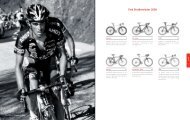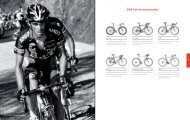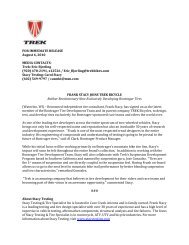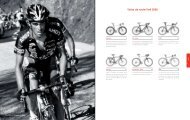SeSSion SUSpeNSION SeTUp gUIDe
SeSSion SUSpeNSION SeTUp gUIDe
SeSSion SUSpeNSION SeTUp gUIDe
Create successful ePaper yourself
Turn your PDF publications into a flip-book with our unique Google optimized e-Paper software.
COIL FORK Suspension Setup Guide<br />
(session 88 only)<br />
Tools needed to adjust Fox fork :<br />
Fork sag indicator<br />
A person to hold you up<br />
Follow these steps to optimize the performance of your Trek Full Suspension Mountain Bike front suspension:<br />
1.<br />
2.<br />
3.<br />
4.<br />
5.<br />
6.<br />
7.<br />
8.<br />
9.<br />
10.<br />
Install suggested spring rate based on rider weight (include rider + gear)<br />
Adjust high speed compression [RC2 only]<br />
a) Turn adjustment knob clockwise until knob stops – this is your base setting<br />
b) Turn knob counter-clockwise to your recommended setting.<br />
Adjust low speed compression [RC2 only]<br />
Turn adjustment knob clockwise until knob stops – this is your base setting<br />
Turn knob counter-clockwise to your recommended setting<br />
Adjust rebound<br />
a) Turn adjustment knob clockwise until knob stops – this is your base setting<br />
b) Turn knob counter-clockwise to your recommended setting<br />
Make sure the coil is preloaded properly<br />
a) Turn spring preload adjustment knob counter-clockwise to minimum setting.<br />
Mount bike and have your friend hold you up. Cycle fork, settling into a standing riding stance centered on the bike. Slide o-ring on stanchion down to contact seal head.<br />
Dismount and check o-ring placement in comparison to sag indicator marks. Compare your measurement with the suggested fork sag range.<br />
a) If sag is too great, you can turn preload adjustment knob as necessary. If you reach maximum preload adjustment range and you still have too much sag, it is recommended that you go up to the next spring rate.<br />
b) If sag is too little and you are at minimum preload, it is recommended that you go to the next softer rate.<br />
c) If you do not achieve proper sag, swap to the appropriate spring and repeat steps #1-8.<br />
It’s important to note that spring rate is a highly personal setting. Some riders prefer a firmer spring rate for more control on big hits, while others prefer a lower spring rate for optimized suspension performance on lowerspeed<br />
technical terrain. Consider riding a variety of spring rates to determine your optimal setting.<br />
4

















